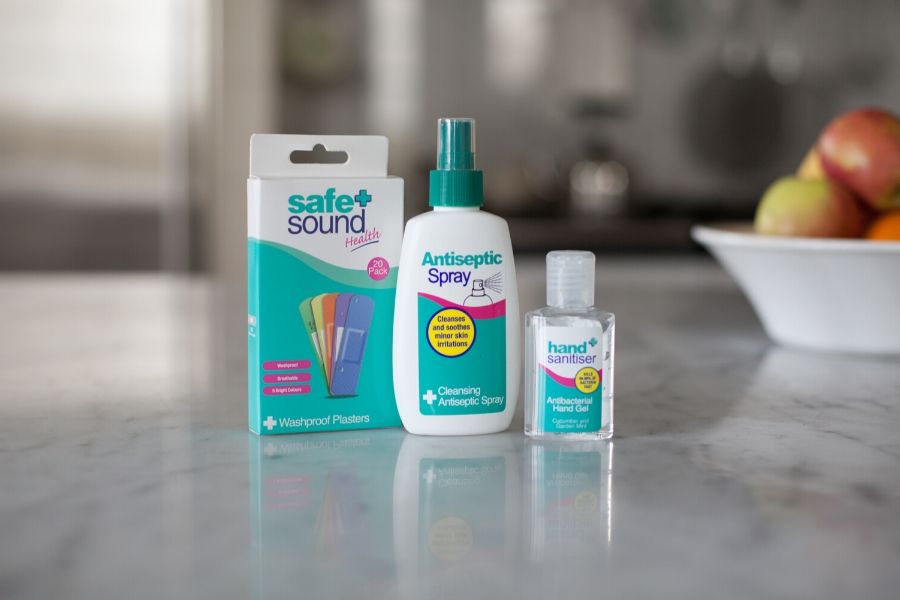Top tips for basic first aid
Basic first aid is easy to grasp, and everyone should have a few skills under their belt.
One of the things that you can pick up quickly is how to treat a minor wound, like a cut or skin graze. When treating these injuries, the aim is to keep them clean and prevent infection to allow them to heal. There are three key steps that you can take to achieve this, which are easy to remember every time.
When treating a wound, you should follow these steps: 1) wash your hands, 2) clean the wound, 3) protect the wound.
Let’s look at how you can make sure your first aid kit is stocked and ready to do these things every time.
 1) Wash your hands
1) Wash your hands
Thoroughly washing your hands before you administer first aid for cuts and other wounds will prevent germs from your hands getting into the wound. You should wash your hands with soap and water, making sure to clean the backs and palms of your hands and between your fingers. If you don’t have access to clean water and soap, antibacterial gel is a useful alternative. It’s handy to have in your mini first aid kit, but it’s also useful just to carry it around, especially if you’re someone who likes to get their hands dirty. Antibacterial gel is ideal for outdoor first aid, so remember to pack some if you’re going camping, hiking or cycling.
Your hands might not look dirty, but they could still be covered in germs. If you touch an open wound that you or someone else has, you could risk introducing bacteria into the wound. An infection could take longer to heal, could need further treatment, and might even require antibiotic medications.

2) Clean the wound
The next step to prevent infection is to clean the wound itself. Whether it’s a cut, scratch or scrape, if bacteria gets into the wound, it could end up causing an infection and making it worse. There are several ways you can clean a wound with a few basic cuts and grazes first aid skills. If you have clean water available, washing it over the wound is a simple way to get rid of any debris. You can use an antiseptic spray or antiseptic wipes to clean a wound too, and antiseptic wash products and antiseptic creams are also available.
Don’t worry if the wound is bleeding a little. This can help to clean out the wound, and a minor wound will usually stop bleeding fairly quickly. Small cuts and scrapes will normally stop bleeding on their own. Cuts in some areas can bleed more, such as those on the head or hand, where there are lots of blood vessels. It can help to apply firm pressure to the wound, using clean gauze or a clean cloth. If there is heavy bleeding or the bleeding won’t stop, you should seek medical help. Once the bleeding has stopped, you can disinfect the wound.

3) Cover and protect the wound
When you’re treating cuts and grazes, protecting the wound is the last important step. It needs to be allowed to heal without interference, and shouldn’t take too long to start looking and feeling better. Protecting the wound is about both preventing bacteria and dirt from getting into it, as well as allowing a scab to form and stay in place until the skin has healed.
A plaster is usually perfect for covering a small wound. There are many different types of plaster available, from waterproof plasters to fabric plasters, see-through plasters, and bright blue plasters ideal for the workplace. You can also find different shapes and sizes, which make it easier to cover injuries in awkward places, from the heel of your foot to your fingers. A dressing or bandage might be more appropriate for some wounds if a plaster isn’t the right shape or size.
Many people think that you should let wounds breathe. However, some studies have shown that it’s actually better to keep a wound moist and covered to help it heal. Using an antiseptic cream or a similar products with a plaster or bandage to cover the wound will help it to heal. If the plaster or dressing gets dirty, make sure to change it.
Use best practice for first aid for wounds by following our top three tips. These three steps will ensure the wound stays clean and heals quickly. Wash your hands, clean the wound, then cover it to protect it for the best results.

Safe and Sound Health has an extensive range of wound-care products and plasters than can carry around with you or use at home when treating minor cuts or grazes. Visit their website at www.safeandsoundhealth.co.uk to find out more or browse their full range of first aid products.





















